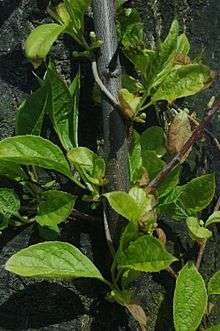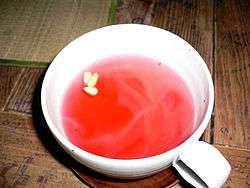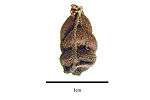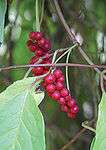Schisandra chinensis
| Schisandra chinensis | |
|---|---|
 | |
| Scientific classification | |
| Kingdom: | Plantae |
| (unranked): | Angiosperms |
| Order: | Austrobaileyales |
| Family: | Schisandraceae |
| Genus: | Schisandra |
| Species: | S. chinensis |
| Binomial name | |
| Schisandra chinensis (Turcz.) Baill.[1] | |
| Synonyms | |

Schisandra chinensis (五味子 in Chinese, pinyin: wǔ wèi zi, literally "five-flavor berry" which is its common name[1]) is a deciduous woody vine native to forests of Northern China and the Russian Far East. It is hardy in USDA Zone 4. The plant likes some shade with moist, well-drained soil. The species itself is dioecious, thus flowers on a female plant will only produce fruit when fertilized with pollen from a male plant. However, a hybrid selection titled 'Eastern Prince' has perfect flowers and is self-fertile. Seedlings of 'Eastern Prince' are sometimes sold under the same name, but are typically single-sex plants.
Growing information
Schisandra is native to northern and northeastern China (Manchuria). Cultivation requirements are thought to be similar to those of grapes.[5][6] Plants require conditions of moderate humidity and light, together with a wet, humus-rich soil. Tens of tons of berries are used annually in Russia in Primorsky Krai and Khabarovsk Krai for the commercial manufacture of juices, wines, extracts, and sweets.
Etymology
Its Chinese name comes from the fact that its berries possess all five basic flavors: salty, sweet, sour, pungent (spicy), and bitter. Sometimes, it is more specifically called běi wǔ wèi zi ((Chinese: 北五味子); literally "northern five-flavor berry") to distinguish it from another traditionally medicinal schisandraceous plant Kadsura japonica that grows only in subtropical areas. Another species of schisandra berry, Schisandra sphenanthera, has a similar but different biochemical profile; the Chinese pharmacopia distinguishes between S. chinensis (běi wǔ wèi zi) and S. sphenanthera (nan wǔ wèi zi).[7]
Medicinal uses
Its berries are used in traditional Chinese medicine, where it is considered one of the 50 fundamental herbs. Chemical constituents include the lignans schisandrin, deoxyschisandrin, gomisins, and pregomisin, which are found in the seeds of the fruit. It should not be used by pregnant women.
In China, a wine is made from the berries.[8]
In Korean, the berries are known as omija (hangul: 오미자 – five flavours). The cordial drink made from the berries is called omija cha (hangul: 오미자 차), meaning "omija tea"; see Korean tea.
In Japanese, they are called gomishi (Japanese: ゴミシ). The Ainu people used this plant, called repnihat, as a remedy for colds and sea-sickness.[9]
In traditional Chinese medicine, S. chinensis (known as wu wei zi (Chinese: 五味子)) is believed to act as an astringent for the Qi of the lungs and kidneys, restrain the essence to treat diarrhea, arrest excessive sweating from deficiency of yin or yang, calm the spirit by refreshing the heart and kidneys, and generate body fluid and reduce thirst.
The great interest in limonnik (S. chinensis) in Russia arises from results of ethnopharmacological investigations of Russian scientists in the Far East regions where the berries and seeds were used by Nanai (Goldes or Samagir) hunters to improve night vision, as a tonic and to reduce hunger, thirst and exhaustion since “it gives forces to follow a sable all the day without food”.[10] "Pharmacological studies on animals have shown that Schisandra increases physical working capacity and affords a stress-protective effect against a broad spectrum of harmful factors including heat shock, skin burn, cooling, frostbite, immobilisation, swimming under load in an atmosphere with decreased air pressure, aseptic inflammation, irradiation, and heavy metal intoxication. The phytoadaptogen exerts an effect on the central nervous, sympathetic, endocrine, immune, respiratory, cardiovascular, gastrointestinal systems, on the development of experimental atherosclerosis, on blood sugar and acid-base balance, and on uterus myotonic activity."[10]
Chemistry
Two major lignans, schisandrin and gomisin A, have been shown to induce interleukin (IL)-8, macrophage inflammatory protein-1β, and granulocyte-macrophage-colony stimulating factor (GM-CSF) release by THP-1 cells. Therefore, S. chinensis may be therapeutically beneficial in promoting the body's humoral and cell-mediated immune responses.[11]
Schisandrin is one of the main dibenzocyclooctadiene lignans present in the fruit of S. chinensis. In vitro biological activities including hepatoprotective, antiviral, and neuroprotective effects of schisandrin and other dibenzocyclooctadiene lignans have been reported.[12]
Recent studies have demonstrated that schisandrin exhibits antioxidative effects in mice.[13]
Other chemical constituents include schisandrin B, γ-terpinene, bisabolene (+)-gomisin K2, gomisin S, pregomisin, schisantherin A, schicantherin B, angeloylgomisin Q, and rubrildilactione.[14]
Culture
In 1998, Russia released a postage stamp depicting S. chinensis.photo (Russian: Лимонник китайский)
Gallery
 Fruit
Fruit Seeds
Seeds Berries
Berries


See also
References
- 1 2 3 "Schisandra chinensis information from NPGS/GRIN". USDA. Retrieved 2008-02-19.
- ↑ "Eternal Youth Berry – Who needs the fountain with this berry around?". www.michiganbulb.com. Retrieved 2014-12-23.
- ↑ "Schisandra chinensis (Magnolia Vine)". www.vanmeuwen.com. Retrieved 2014-12-23.
- 1 2 3 "Schisandra chinensis – Plants For A Future database report". www.pfaf.org. Retrieved 2008-03-10.
- ↑ http://bayflora.com/magnoliavine.html
- ↑ http://whatcom.wsu.edu/ag/homehort/plant/Magnolia.htm
- ↑ Difference between Schisandra chinensis and Schisandra sphenanthera
- ↑
- ↑ Batchelor, John; Miyabe, Kingo (1893). "Ainu economic plants". Transactions of the Asiatic Society of Japan. R. Meiklejohn & Co. 51: 198–240.
- 1 2 Panossian A. Wikman G. "Pharmacology of Schisandra chinensis Bail.: an overview of Russian research and uses in medicine. [Review]" Journal of Ethnopharmacology. 118(2):183–212, 2008 Jul 23.
- ↑ Lin RD, Mao YW, Leu SJ, Huang CY, Lee MH. "The immuno-regulatory effects of Schisandra chinensis and its constituents on human monocytic leukemia cells." Molecules. 2011;16(6):4836-49
- ↑ Kim SJ. Min HY. Lee EJ. Kim YS. Bae K. Kang SS. Lee SK. 'Growth inhibition and cell cycle arrest in the G0/G1 by schisandrin, a dibenzocyclooctadiene lignan isolated from Schisandra chinensis, on T47D human breast cancer cells." Phytotherapy Research. 24(2):193-7, 2010 Feb.
- ↑ Guo LY. Hung TM. Bae KH. Shin EM. Zhou HY. Hong YN. Kang SS. Kim HP. Kim YS., "Anti-inflammatory effects of schisandrin isolated from the fruit of Schisandra chinensis Baill." European Journal of Pharmacology. 591(1–3):293-9, 2008 Sep 4.
- ↑ Xu XM, Li L, Chen M., "Studies on the chemical constituents of Schisandra pubescens". Zhong Yao Cai. 2009 Sep;32(9):1399-401.
Further reading
- Winston, David, and Steven Maimes. ADAPTOGENS: Herbs for Strength, Stamina, and Stress Relief. Healing Arts Press, 2007. (Contains a detailed monograph on S. chinensis as well as a discussion of health benefits.)